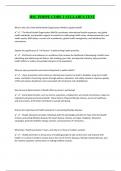HSC PDHPE CORE 1 SYLLABUS TEST
What is the role of the World Health Organization (WHO) in global health?
✔️✔️ The World Health Organization (WHO) coordinates international health responses, sets global
health standards, and provides support to countries in addressing health crises, disease prevention, and
health equity. WHO plays a crucial role in pandemics, global health emergencies, and initiatives like
vaccinations.
Explain the significance of "risk factors" in determining health priorities.
✔️✔️ Risk factors are behaviors or conditions that increase the likelihood of developing a health issue.
Identifying and addressing risk factors, like smoking, poor diet, and physical inactivity, helps prioritize
health efforts to reduce preventable diseases in the population.
Why are injury prevention and control important in public health?
✔️✔️ Injury prevention and control are vital because injuries can lead to disability, long-term health
issues, and death. Preventing injuries through policies, education, and safety measures improves quality
of life and reduces healthcare costs associated with treatment and rehabilitation.
How do social determinants of health affect a person’s well-being?
✔️✔️ Social determinants, such as income, education, employment, and social connections, impact an
individual's physical and mental health. These factors influence lifestyle choices, access to healthcare,
and stress levels, all of which contribute to overall well-being.
Discuss the importance of health education in preventing lifestyle diseases.
✔️✔️ Health education provides individuals with the knowledge and skills to make informed health
choices, preventing lifestyle diseases like heart disease, obesity, and type 2 diabetes. Education
campaigns promote healthier eating, exercise, and awareness of risk factors.
What does "health promotion" mean, and why is it critical in modern society?
✔️✔️ Health promotion is the process of enabling people to take control over and improve their
health. It is critical in modern society due to the rise of chronic diseases, lifestyle-related illnesses, and
the need to empower communities in making healthier choices.
, Explain how smoking affects public health in Australia.
✔️✔️ Smoking is a leading cause of preventable disease and death in Australia, associated with lung
cancer, heart disease, and respiratory conditions. Reducing smoking rates through policies and
education is essential to improving public health outcomes.
How does the physical environment influence health behavior?
✔️✔️ The physical environment, including access to parks, safe neighborhoods, and recreational
facilities, encourages or discourages physical activity and healthy lifestyles. Poor environments can lead
to sedentary behaviors, higher stress levels, and health issues like obesity.
What role do community health centers play in public health?
✔️✔️ Community health centers provide accessible healthcare, especially in underserved areas. They
offer preventive services, education, and support, reducing the burden on hospitals and improving the
health of local populations.
Describe how “health literacy” impacts an individual’s health outcomes.
✔️✔️ Health literacy refers to the ability to understand and use health information to make informed
decisions. Higher health literacy enables individuals to navigate healthcare systems, follow medical
advice, and manage their health effectively, leading to better outcomes.
Why is equity in healthcare important for public health?
✔️✔️ Equity in healthcare ensures all individuals have fair access to health services, regardless of
background. This reduces health disparities, improves health outcomes across populations, and
promotes social justice by addressing needs in disadvantaged groups.
Discuss how cultural factors influence health behaviors.
✔️✔️ Cultural factors shape beliefs, practices, and attitudes towards health, such as dietary habits,
views on exercise, and healthcare-seeking behaviors. Recognizing cultural influences helps tailor health
programs to diverse communities for better engagement and outcomes.
What are the benefits of regular physical activity for mental health?




